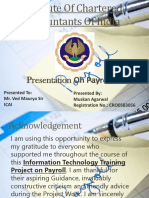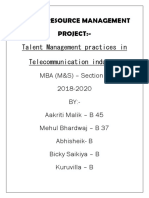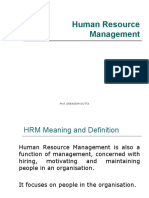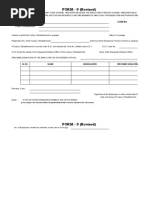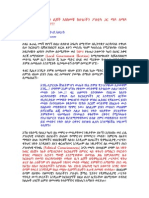Difference Between HR & Admin
Uploaded by
DS SystemsDifference Between HR & Admin
Uploaded by
DS SystemsDIFFERENCE BETWEEN HR AND ADMIN
Administration KRA
1. Scheduling
2. Project Support
3. Safety & Health Management
4. Vehicle Management
5. Visitor Protocol
6. Records Management
7. Filing
8. Administrative Support.
9. Internal Customer relations.
10. Equipment maintenance
Administrative KRAs 2
1. Registration Processes
2. Solving Legal issues
3. Safety management
4. Coordination with vendors
5. Taking care of House Keeping (Cleanness)
6. Infrastructure Management
7. Lodging and traveling arrangement
8. Stationary requirements
9. Some places it includes attendance management too
Administrative KRA 3
1. Local Transport Management (car rental etc)
2. Travel (bus, train) and hotel bookings
3. Stationery procurement & consumption monitoring
4. Employee related activities – Access cards, Visiting cards etc
5. Pantry operation (tea/coffee etc) & catering service
6. Courier management
7. Fax & photocopy machine
8. Phone & Mobile issual to and retrieval from employees (Typical to telecom industry)
9. Liasioning with statutory agencies and statutory compliances (PF, ESIC, Labour Inspector etc)
Administration KRAs 4
1. Local Transport Management (car rental etc)
2. Travel (bus, train) and hotel bookings
3. Stationery procurement & consumption monitoring
4. Employee related activities – Access cards, Visiting cards etc
5. Pantry operation (tea/coffee etc) & catering service
6. Courier management
7. Fax & photocopy machine
8. Phone & Mobile issual to and retrieval from employees (Typical to telecom industry)
9. Liasioning with statutory agencies and statutory compliances (PF, ESIC, Labour Inspector etc)
10. Cost reduction
11. Responsive time
12. Maintenance (Cleaning, supply, etc)
13. Stationary management
14. Vendor management
15. Registration Processes
16. Solving Legal issues
17. Safety management
18. Coordination with vendors
19. Taking care of House Keeping (Cleanness)
20. Infrastructure Management
21. Lodging and traveling arrangement
22. Stationary requirements
23. Some places it includes attendance management too
Human resources KRAs
1. Recruitment & Selection
• Reduce Average time taken to fill vacancies
• Reduce Average cost per recruitment
• Finalize selection in 5 weeks for each individual position
• Workplace accidents
• Reduce workplace accidents
2. Building capabilities and organizing learning
• Training
• All workforces below middle management should receive a minimum of 4 days training.
• Maximize induction training. Maximize training workshops
• Employees Development
• Training needs analysis & Competencies development.
3. Performance Management
• Performance Appraisal
• Managing Employees through KRAs
• Achieve 100% performance appraisals against total employees.
4. Monitoring employee deployment
5. Compensation and benefits.
6. Employee Relations
7. Statutory Compliance
8. Reward Management
9. Effective HR management systems, support & monitoring
10. Workplace Management
• Reduction in absenteeism per employees
• Increase in employee satisfaction
• Talent retention and turnover ratio
• Reduce the labor turnover
• Benchmark total HR costs externally.
You might also like
- Job Description and KRA For Recruiting ManagerNo ratings yetJob Description and KRA For Recruiting Manager2 pages
- Recruitment - Introduction PresentationNo ratings yetRecruitment - Introduction Presentation15 pages
- YSLP Final Placement - Campus PresentationNo ratings yetYSLP Final Placement - Campus Presentation44 pages
- Human Resource Management Professional With 9+ Years of Success in100% (1)Human Resource Management Professional With 9+ Years of Success in3 pages
- Diploma in Indian Payroll & Compliance Management PDFNo ratings yetDiploma in Indian Payroll & Compliance Management PDF8 pages
- Oracle Apps - R12 - High Level Setup For Core HR: Basic Administration ChecklistNo ratings yetOracle Apps - R12 - High Level Setup For Core HR: Basic Administration Checklist2 pages
- Randstad Sourceright 2019 Talent Trends Report 190118No ratings yetRandstad Sourceright 2019 Talent Trends Report 19011828 pages
- Standard Operating Procedures Manual 2013-2014: Management Information Systems Division100% (1)Standard Operating Procedures Manual 2013-2014: Management Information Systems Division29 pages
- Number Sub-Objective Target Action Accountability ResourcesNo ratings yetNumber Sub-Objective Target Action Accountability Resources28 pages
- CEO Managing Director SVP COO in USA Resume Mike FreemanNo ratings yetCEO Managing Director SVP COO in USA Resume Mike Freeman1 page
- Shri Harini Media Ltd. Business Development Incentive Plan PolicyNo ratings yetShri Harini Media Ltd. Business Development Incentive Plan Policy7 pages
- Human Resource Management: Prof. Debasish DuttaNo ratings yetHuman Resource Management: Prof. Debasish Dutta64 pages
- InfoCepts Policy For Salary Advances LoansNo ratings yetInfoCepts Policy For Salary Advances Loans10 pages
- Project Report On Scope of Recruitment Process Outsourcing93% (15)Project Report On Scope of Recruitment Process Outsourcing32 pages
- Pooja Arora - SOP Project - HR & Admn. ActivitiesNo ratings yetPooja Arora - SOP Project - HR & Admn. Activities109 pages
- Retail Facilities Maintenance: the Circle of Management: A 30-Year Experience Management NarrativeFrom EverandRetail Facilities Maintenance: the Circle of Management: A 30-Year Experience Management NarrativeNo ratings yet
- Government System Of: National Informatics CentreNo ratings yetGovernment System Of: National Informatics Centre35 pages
- Three Cover Bid Submission New v906 PDFNo ratings yetThree Cover Bid Submission New v906 PDF61 pages
- Frequently Encountered Problems and SolutionsNo ratings yetFrequently Encountered Problems and Solutions4 pages
- Revised KYC Text File Structure 2.0: S. No. Field Name Type Size Validation RemarkNo ratings yetRevised KYC Text File Structure 2.0: S. No. Field Name Type Size Validation Remark6 pages
- Work Activity Log Sheet: Date Work Number Activity Resources Used Start Time End TimeNo ratings yetWork Activity Log Sheet: Date Work Number Activity Resources Used Start Time End Time2 pages
- Io Games Unblocked - Cookie Clicker - Io 4No ratings yetIo Games Unblocked - Cookie Clicker - Io 41 page
- How To Tell Wild Animals by Carolyn WellsNo ratings yetHow To Tell Wild Animals by Carolyn Wells7 pages
- Alaska Pollock Fishery Alliance Press ReleaseNo ratings yetAlaska Pollock Fishery Alliance Press Release1 page
- ETX-5300A: Ethernet Service Aggregation PlatformNo ratings yetETX-5300A: Ethernet Service Aggregation Platform4 pages
- Noel v. The Boeing Co., 622 F.3d 266, 3rd Cir. (2010)No ratings yetNoel v. The Boeing Co., 622 F.3d 266, 3rd Cir. (2010)18 pages
- School Education Department - Allocation of Employees - Warangal DistrictNo ratings yetSchool Education Department - Allocation of Employees - Warangal District17 pages
- Powering The World'S Most Reputable Companies: Global Reptrak® 100No ratings yetPowering The World'S Most Reputable Companies: Global Reptrak® 10072 pages













